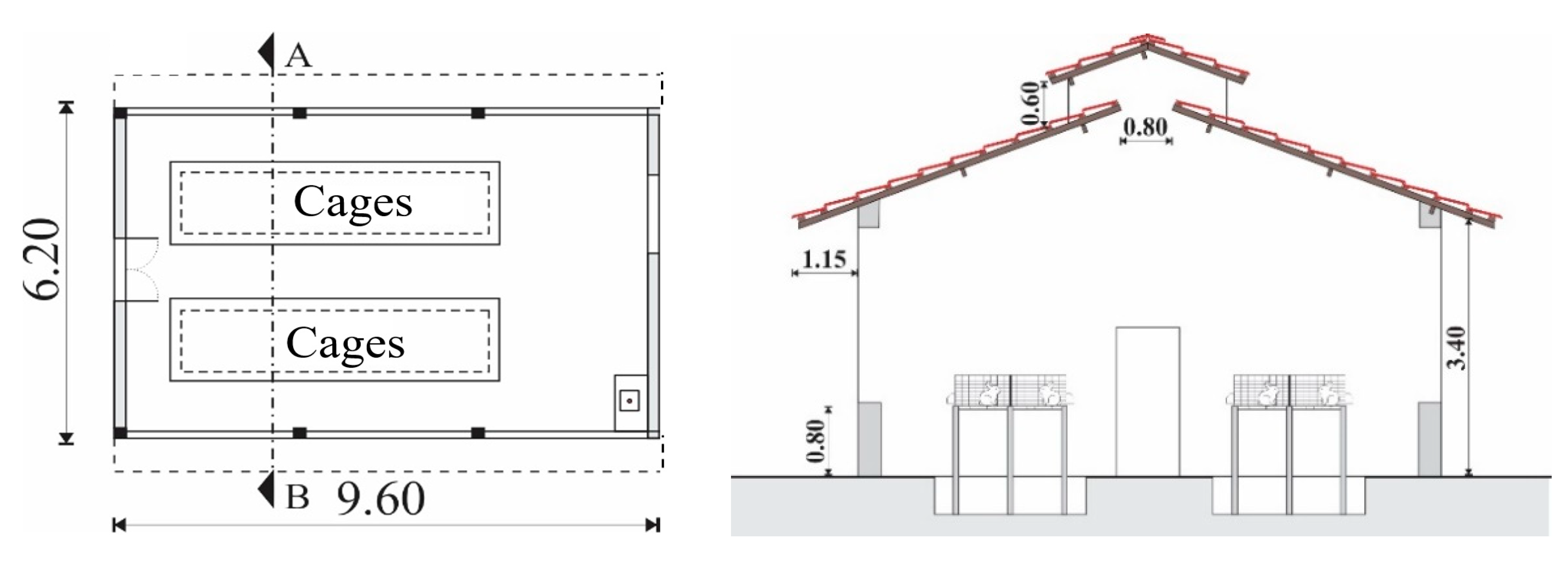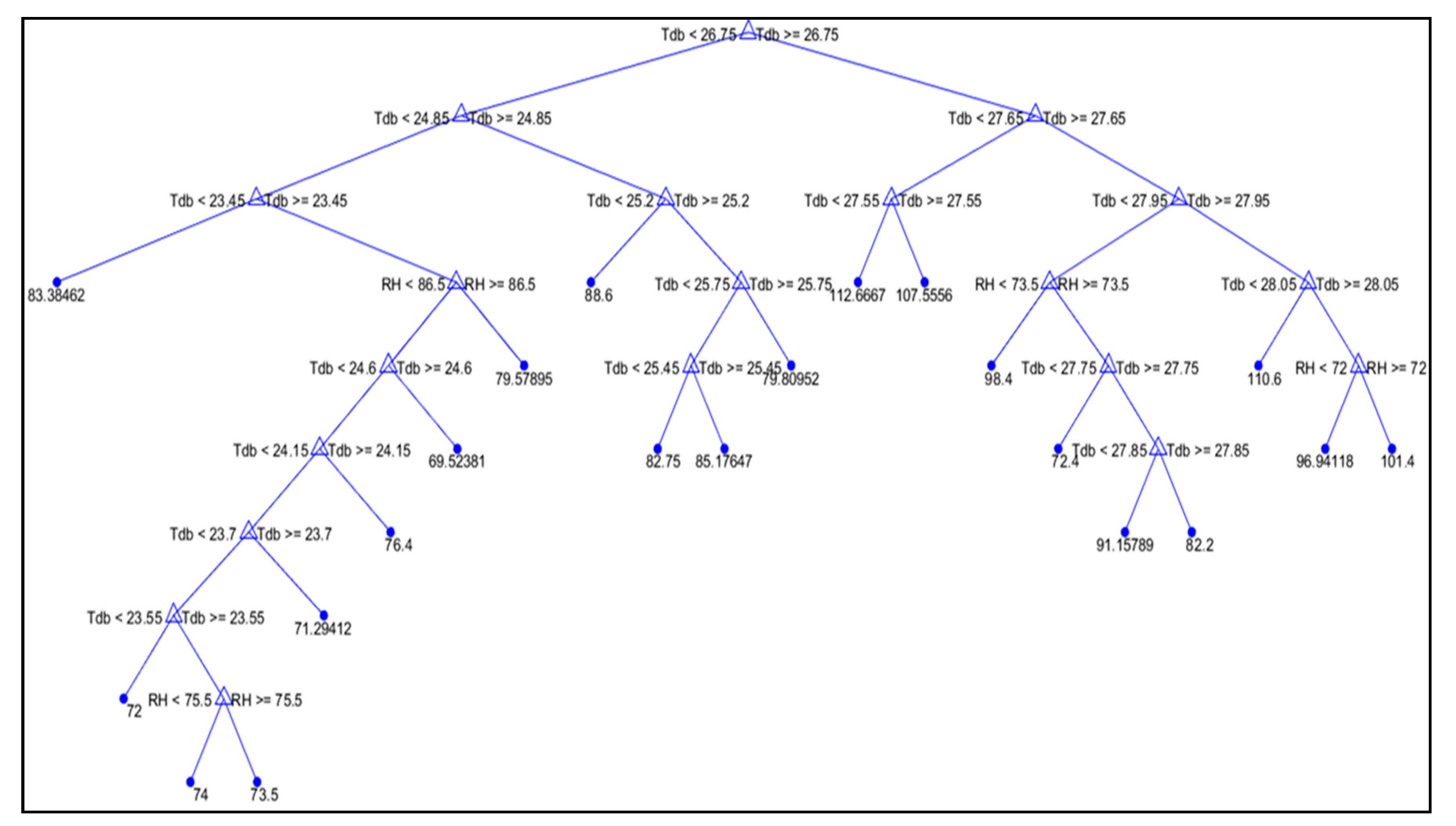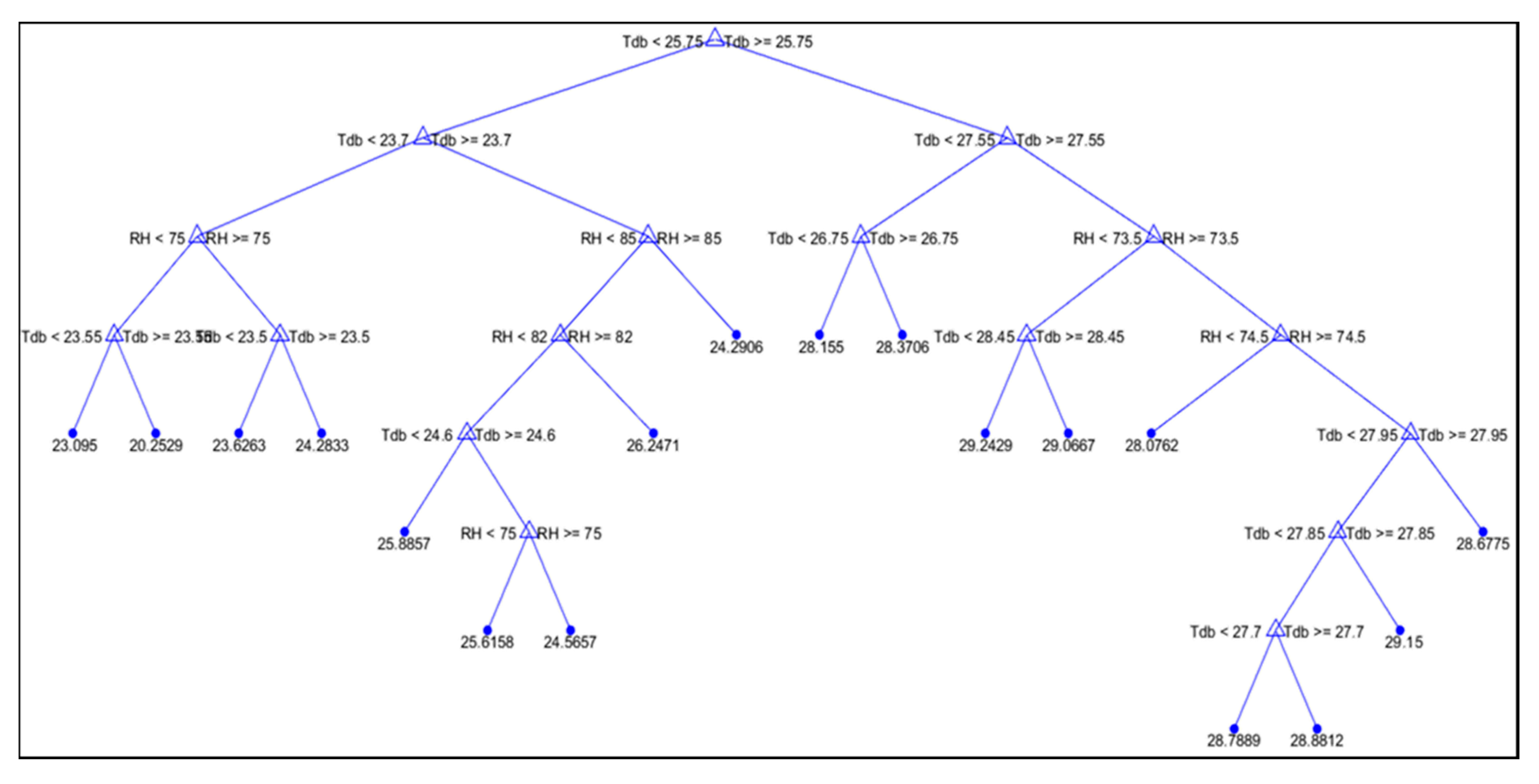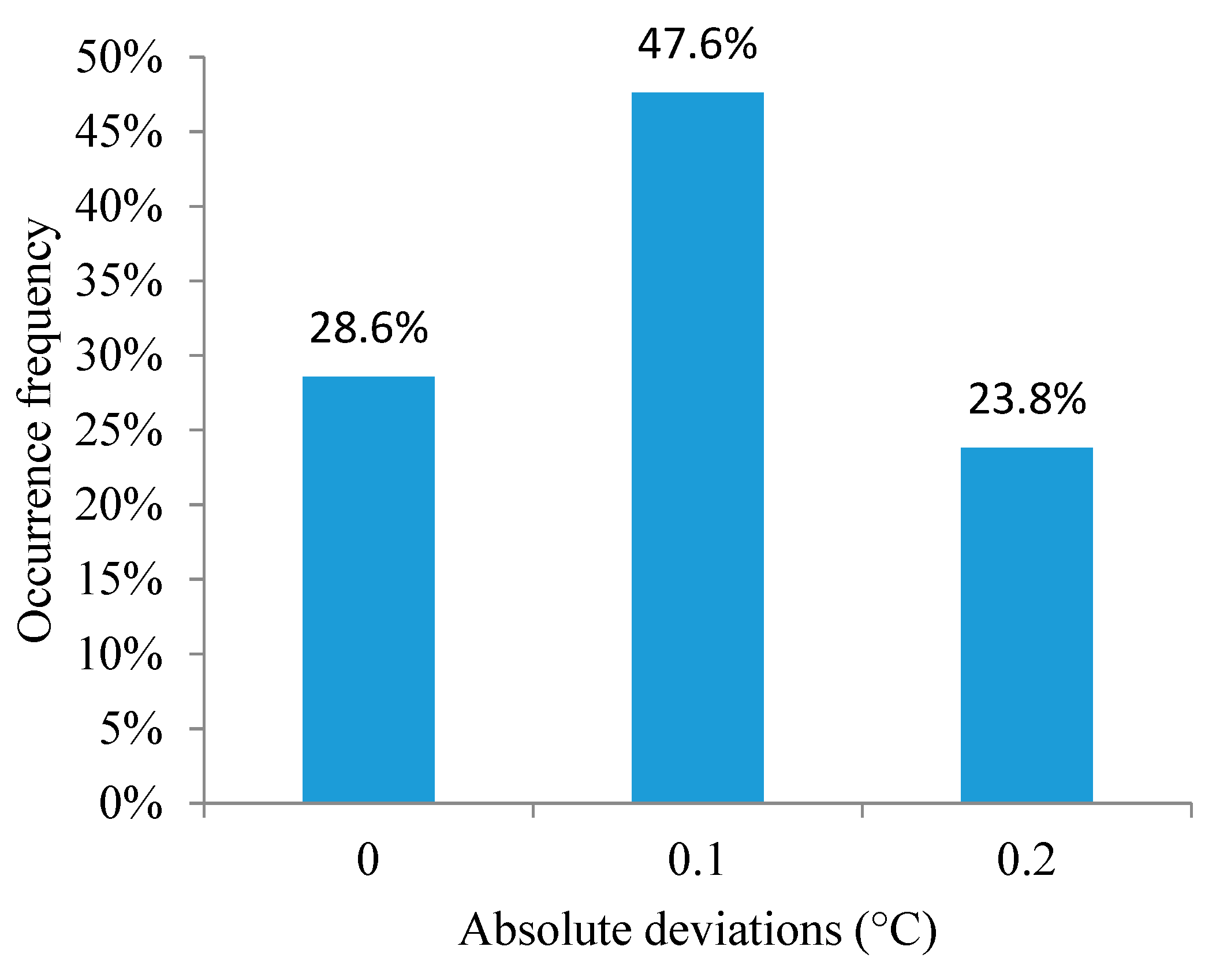Decision Trees for Predicting the Physiological Responses of Rabbits
Simple Summary
Abstract
1. Introduction
2. Materials and Methods
2.1. Housing and Animals
2.2. Environmental and Physiological Response Measurements
2.3. Dataset
Data Partition Method for Validation of the Models
2.4. Data Preparation
2.5. Decision Tree Model Development
Decision Tree Model Parameters
3. Results and Discussion
4. Conclusions
Author Contributions
Funding
Acknowledgments
Conflicts of Interest
References
- Ferraz, P.F.P.; Ferraz, G.A.S.; Damasceno, F.A.; Moura, R.S.; Silva, M.A.J.G.; Lima, R.R. Spatial variability of enthalpy in rabbit house with and without ridge vent. Rev. Bras. Eng. Agríc. Ambient. 2019, 23, 126–132. [Google Scholar] [CrossRef]
- Bodnár, K.; Bodnár, G.; Makra, L.; Fülöp, A.; Farkas, Z.; Csépe, Z.; Privóczki, Z.I. Technical note. Improving the microclimate of a rabbit house: Thermal insulation and air handling. World Rabbit Sci. 2019, 27, 49. [Google Scholar] [CrossRef]
- Ferraz, P.F.P.; Ferraz, G.A.S.; Barbari, M.; Silva, M.A.J.G.; Damasceno, F.A.; Cecchin, D.; Castro, J.O. Behavioural and physiological responses of rabbits. Agron. Res. 2019, 17, 704–710. [Google Scholar]
- Cervera, C.; Carmona, F.J. Nutrition and the Climatic Environment. In The Nutrition of the Rabbit, 2nd ed.; de Blas, C., Wiseman, J., Eds.; CABI Publishing: Wallingford, UK, 2010; pp. 273–295. [Google Scholar]
- Ferreira, W.M.; Machado, L.C.; Jaruche, Y.D.G.; Carvalho, G.D.; Oliveira, C.E.A.; Souza, J.A.S.; Caríssimo, A.P.G. (Eds.) Manual Prático de Cunicultura; Associação Brasileira de Cunicultura: Bambuí, Brazil, 2012; p. 75. [Google Scholar]
- Sandford, J.C. The Domestic Rabbit, 4th ed.; Collins: London, UK, 1986. [Google Scholar]
- Marai, I.F.M.; Habeeb, A.A.M.; Gad, A.E. Rabbits’ productive, reproductive and physiological performance traits as affected by heat stress: A review. Livest. Prod. Sci. 2002, 78, 71–90. [Google Scholar] [CrossRef]
- Zeferino, C.P.; Moura, A.S.A.M.T.; Fernandes, S.; Kanayama, J.S.; Scapinello, C.; Sartori, J.R. Genetic group × ambient temperature interaction effects on physiological responses and growth performance of rabbits. Livest. Sci. 2011, 140, 177–183. [Google Scholar] [CrossRef]
- Konradi, G. Textbook of Physiology; Kova, K.M., Ed.; Foreign Languages Publishing House: Moscow, Russia, 1960. [Google Scholar]
- Ferreira, R.A.; Moura, R.S.; Amaral, R.C.; Vilas, P.; Ribeiro, B.; Oliveira, R.F.; Piva, A.E. Estresse agudo por calor em coelhos. Rev. Bras. Cunicult. 2017, 12, 45–56. [Google Scholar]
- Ma, L.; Destercke, S.; Wang, Y. Online active learning of decision trees with evidential data. Pattern Recognit. 2016, 52, 33–45. [Google Scholar] [CrossRef]
- Sok, H.K.; Ooi, M.P.L.; Kuang, Y.C.; Demidenko, S. Multivariate alternating decision trees. Pattern Recognit. 2016, 50, 195–209. [Google Scholar] [CrossRef]
- Williams, F.M.; Rothe, H.; Barrett, G.; Chiodini, A.; Whyte, J.; Cronin, M.T.; Yang, C. Assessing the safety of cosmetic chemicals: Consideration of a flux decision tree to predict dermally delivered systemic dose for comparison with oral TTC (Threshold of Toxicological Concern). Regul. Toxicol. Pharmacol. 2016, 76, 174–186. [Google Scholar] [CrossRef]
- Velásquez, L.; Tirado, J.P.C.; Siche, R.; Quevedo, R. An application based on the decision tree to classify the marbling of beef by hyperspectral imaging. Meat Sci. 2017, 133, 43–50. [Google Scholar] [CrossRef]
- Wang, X.; Liu, X.; Pedrycz, W.; Zhang, L. Fuzzy rule based decision trees. Pattern Recognit. 2015, 48, 50–59. [Google Scholar] [CrossRef]
- Lim, T.; Loh, W.; Shih, Y. An Empirical Comparison of Decision Trees and Other Classification Methods; Technical Report; Department of Statistics, University of Wisconsin: Madison, WI, USA, 1997. [Google Scholar]
- Gehrke, J.; Ganti, V.; Ramakrishnan, R.; Loh, W.Y. BOAT-optimistic decision tree construction. In Proceedings of the International Conference on Management of Data (SICMOD), Philadelphia, PA, USA, 31 May–3 June 1999; pp. 169–180. [Google Scholar]
- Manwani, N.; Sastry, P. Geometric decision tree. IEEE Trans. Syst. Man Cybern. B 2012, 42, 181–192. [Google Scholar] [CrossRef] [PubMed]
- Mehta, R.M.; Agrawal, R.; Rissanen, J. SLIQ: A fast-scalable classifier for data mining. In Advances in Database Technology-EDBT ’96; Springer: Berlin/Heidelberg, Germany, 1996; pp. 18–32. [Google Scholar]
- Cervantes, J.; Lamont, F.G.; López-Chau, A.; Mazahua, L.R.; Ruíz, J.S. Data selection based on decision tree for SVM classification on large data sets. Appl. Soft Comput. 2015, 37, 787–798. [Google Scholar] [CrossRef]
- Vieira, E.M.A.; Neves, N.T.A.T.; Oliveira, A.C.C.; Moraes, R.M.; Nascimento, J.A. Avaliação da performance do algoritmo J48 para construção de modelos baseados em árvores de decisão. Rev. Bras. Comput. Apl. 2018, 10, 80–90. [Google Scholar]
- Blasco Mateu, A.; Ouhayoun, J.; Masoero, G. Harmonization of criteria and terminology in rabbit meat research. World Rabbit Sci. 1993. [Google Scholar] [CrossRef]
- De Blas, C.; Mateos, G.G. Feed formulation. In Nutrition of the Rabbit, 2nd ed.; de Blas, C., Wiseman, J., Eds.; CAB International: Wallingford, UK, 2010; p. 229. [Google Scholar]
- Hernández-Julio, Y.F.; Prieto-Guevara, M.J.; Nieto-Bernal, W.; Meriño-Fuentes, I.; Guerrero-Avendaño, A. Framework for the Development of Data-Driven Mamdani-Type Fuzzy Clinical Decision Support Systems. Diagnostics 2019, 9, 52. [Google Scholar] [CrossRef]
- Ferraz, P.F.P.; Yanagi Junior, T.; Hernandez-Julio, Y.F.; Ferraz, G.A.S.; Silva, M.A.J.G.; Damasceno, F.A. Genetic fuzzy system for prediction of respiratory rate of chicks subject to thermal challenges. Rev. Bras. Eng. Agríc. Ambient. 2018, 22, 412–417. [Google Scholar] [CrossRef]
- Riza, L.S.; Bergmeir, C.N.; Herrera, F.; Benítez Sánchez, J.M. Frbs: Fuzzy rule-based systems for classification and regression in R. J. Stat. Softw. 2015, 65, 1–30. [Google Scholar] [CrossRef]
- The MathWorks Inc. Decision Trees (Version 2017); The MathWorks Inc.: Natick, MA, USA, 2017; Available online: https://www.mathworks.com/help/stats/decision-trees.html (accessed on 5 June 2019).
- Ludwig, N.; Gargano, M.; Luzi, F.; Carenzi, C.; Verga, M. Applicability of infrared thermography as a non invasive measurements of stress in rabbit. World Rabbit Sci. 2010, 15, 199–206. [Google Scholar] [CrossRef]
- Vianna, D.M.; Carrive, P. Changes in cutaneous and body temperature during and after conditioned fear to context in the rat. Eur. J. Neurosci. 2005, 21, 2505–2512. [Google Scholar] [CrossRef]
- Nalivaiko, E.; Blessing, W.W. Synchronous changes in ear and tail blood flow following salient and noxious stimuli in rabbits. Brain Res. 1999, 847, 343–346. [Google Scholar] [CrossRef]
- Lebas, F.; Coudert, P.; Rouvier, R.; de Rochambeau, H. The Rabbit. Husbandry, Health and Production. In Animal Production and Health Series; FAO: Rome, Italy, 1986. [Google Scholar]
- Bianca, W.; Kunz, P. Physiological reactions of three breeds of goats to cold, heat and high altitude. Livest. Prod. Sci. 1978, 5, 57–69. [Google Scholar] [CrossRef]
- Altan, O.; Pabuçcuoğlu, A.; Altan, A.; Konyalioğlu, S.; Bayraktar, H. Effect of heat stress on oxidative stress, lipid peroxidation and some stress parameters in broilers. Br. Poult. Sci. 2003, 44, 545–550. [Google Scholar] [CrossRef] [PubMed]
- Lublin, A.V.I.S.H.A.Y.; Wolfenson, D.A.V.I.D.; Berman, A.M.I.E.L. Sex differences in blood flow distribution of normothermic and heat-stressed rabbits. Am. J. Physiol. Regul. Integr. Comp. Physiol. 1995, 268, 66–71. [Google Scholar] [CrossRef] [PubMed]
- Renaudeau, D.; Collin, A.; Yahav, S.; Basilio, V.D.; Gourdine, J.L.; Collier, R.J. Adaptation to hot climate and strategies to alleviate heat stress in livestock production. Animal 2012, 6, 707–728. [Google Scholar] [CrossRef]
- Marai, I.F.M.; Ayyat, M.S.; El-Monem, U.A. Growth performance and reproductive traits at first parity of New Zealand White female rabbits as affected by heat stress and its alleviation under Egyptian conditions. Trop. Anim. Health Prod. 2001, 33, 451–462. [Google Scholar] [CrossRef]
- Ferraz, P.F.P.; Yanagi Junior, T.; Lima, R.R.D.; Ferraz, G.A.; Xin, H. Performance of chicks subjected to thermal challenge. Pesqui. Agropecu. Bras. 2017, 52, 113–120. [Google Scholar] [CrossRef]
- Mujahid, A.; Furuse, M. Behavioral responses of neonatal chicks exposed to low environmental temperature. Poult. Sci. 2009, 88, 917–922. [Google Scholar] [CrossRef]
- Tedeschi, L.O. Assessment of the adequacy of mathematical models. Agric. Syst. 2006, 89, 225–247. [Google Scholar] [CrossRef]
- Ondruska, L.; Rafay, J.; Okab, A.B.; Ayoub, M.A.; Al-Haidary, A.A.; Samara, E.M.; Parkanyi, V.; Chrastinova, L.; Jurcik, R.; Massanyi, P.; et al. Influence of elevated ambient temperature upon some physiological measurements of New Zealand White rabbits. Vet. Med. 2011, 56, 180–186. [Google Scholar] [CrossRef]
- Jaruche, Y.G.; Faria Filho, D.E.F.; Dias, A.N.; Fernandes, D.P.; Ribeiro, H.O.C.; Siqueira, A.A.; Sima, P.S.; Ornelas, O.T.C.; Cruz, L.J.; Caixeta, V.; et al. Efeito da densidade de alojamento sobre a homeostase térmica em coelhas em crescimento mantidas em diferentes temperaturas. Rev. Bras. Cunicult. 2012, 1, 1–42. [Google Scholar]





| Input Variables | Output Variables | ||||
|---|---|---|---|---|---|
| tdb (°C) | RH (%) | RR (mov.min−1) | SD | ET (°C) | SD |
| 23.4 | 76 | 83 | ±14.1 | 23.8 | ±1.8 |
| 23.5 | 70 | 71 | ±15.8 | 22.9 | ±2.1 |
| 23.6 | 77 | 78 | ±16.5 | 24.2 | ±1.5 |
| 23.6 | 74 | 76 | ±14.3 | 20.2 | ±1.5 |
| 23.8 | 86 | 72 | ±20.7 | 24.2 | ±1.6 |
| 24.5 | 78 | 75 | ±11.9 | 25.8 | ±1.5 |
| 24.5 | 87 | 81 | ±22.1 | 24.2 | ±1.9 |
| 24.7 | 77 | 70 | ±18.6 | 24.6 | ±2.0 |
| 25.0 | 73 | 86 | ±17.4 | 25.4 | ±1.9 |
| 25.4 | 84 | 81 | ±21.8 | 26.4 | ±1.7 |
| 25.5 | 80 | 86 | ±14.5 | 24.7 | ±1.7 |
| 26.0 | 73 | 82 | ±22.5 | 28.1 | ±1.0 |
| 27.5 | 72 | 107 | ±23.3 | 28.5 | ±0.9 |
| 27.6 | 81 | 108 | ±28.1 | 28.8 | ±0.9 |
| 27.7 | 73 | 97 | ±28.2 | 29.3 | ±1.0 |
| 27.7 | 74 | 72 | ±12.7 | 28.1 | ±1.2 |
| 27.8 | 84 | 88 | ±23.4 | 28.8 | ±1.5 |
| 27.9 | 82 | 83 | ±32.6 | 29.2 | ±0.9 |
| 28.0 | 75 | 109 | ±23.2 | 28.9 | ±1.0 |
| 28.1 | 77 | 98 | ±23.4 | 28.7 | ±1.3 |
| 29.2 | 67 | 99 | ±28.4 | 29.1 | ±1.2 |
| Parameter | Value |
|---|---|
| SplitCriterion | ‘mse’ |
| MinParent | 10 |
| MinLeaf | 5 |
| MaxSplits | 381 |
| NVarToSample | ‘all’ |
| MergeLeaves | ‘on’ |
| Prune | ‘on’ |
| PruneCriterion | ‘mse’ |
| QEToler | 1.00 × 10−6 |
| NSurrogate | 0 |
| MaxCat | 10 |
| AlgCat | ‘auto’ |
| PredictorSelection | ‘interaction-curvature’ |
| UseChisqTest | 1 |
| Stream | [] |
| Version | 2 |
| Method | ‘tree’ |
| Type | ‘regression’ |
| Parameter | Value |
|---|---|
| SplitCriterion | ‘mse’ |
| MinParent | 14 |
| MinLeaf | 7 |
| MaxSplits | 381 |
| NVarToSample | ‘all’ |
| MergeLeaves | ‘on’ |
| Prune | ‘on’ |
| PruneCriterion | ‘mse’ |
| QEToler | 1.00 × 10−6 |
| NSurrogate | 0 |
| MaxCat | 10 |
| AlgCat | ‘auto’ |
| PredictorSelection | ‘allsplits’ |
| UseChisqTest | 1 |
| Stream | [] |
| Version | 2 |
| Method | ‘tree’ |
| Type | ‘regression’ |
| Input Variables | Output Variables | ||||||||||
|---|---|---|---|---|---|---|---|---|---|---|---|
| tdb (°C) | RH (%) | Observed RR (mov.m−1) | Predicted RR (mov.m−1) | Absolute Deviation | Standard Deviation | Percentage Error | Observed ET (°C) | Predicted ET (°C) | Absolute Deviation | Standard Deviation | Percentage Error |
| 23.4 | 76 | 83 | 83 | 0 | 0.00 | 0.00 | 23.8 | 23.6 | 0.2 | 0.14 | 0.84 |
| 23.5 | 70 | 71 | 72 | 1 | 0.71 | 1.41 | 22.9 | 23.1 | 0.2 | 0.14 | 0.87 |
| 23.6 | 77 | 78 | 73 | 5 | 3.54 | 6.41 | 24.2 | 24.3 | 0.1 | 0.07 | 0.41 |
| 23.6 | 74 | 76 | 74 | 2 | 1.41 | 2.63 | 20.2 | 20.3 | 0.1 | 0.07 | 0.50 |
| 23.8 | 86 | 72 | 71 | 1 | 0.71 | 1.39 | 24.2 | 24.3 | 0.1 | 0.07 | 0.41 |
| 24.5 | 78 | 75 | 76 | 1 | 0.71 | 1.33 | 25.8 | 25.9 | 0.1 | 0.07 | 0.39 |
| 24.5 | 87 | 81 | 80 | 1 | 0.71 | 1.23 | 24.2 | 24.3 | 0.1 | 0.07 | 0.41 |
| 24.7 | 77 | 70 | 70 | 0 | 0.00 | 0.00 | 24.6 | 24.6 | 0 | 0.00 | 0.00 |
| 25.0 | 73 | 86 | 89 | 3 | 2.12 | 3.49 | 25.4 | 25.6 | 0.2 | 0.14 | 0.79 |
| 25.4 | 84 | 81 | 83 | 2 | 1.41 | 2.47 | 26.4 | 26.2 | 0.2 | 0.14 | 0.76 |
| 25.5 | 80 | 86 | 85 | 1 | 0.71 | 1.16 | 24.7 | 24.6 | 0.1 | 0.07 | 0.40 |
| 26.0 | 73 | 82 | 80 | 2 | 1.41 | 2.44 | 28.1 | 28.2 | 0.1 | 0.07 | 0.36 |
| 27.5 | 72 | 107 | 113 | 6 | 4.24 | 5.61 | 28.5 | 28.4 | 0.1 | 0.07 | 0.35 |
| 27.6 | 81 | 108 | 108 | 0 | 0.00 | 0.00 | 28.8 | 28.8 | 0 | 0.00 | 0.00 |
| 27.7 | 73 | 97 | 98 | 1 | 0.71 | 1.03 | 29.3 | 29.2 | 0.1 | 0.07 | 0.34 |
| 27.7 | 74 | 72 | 72 | 0 | 0.00 | 0.00 | 28.1 | 28.1 | 0 | 0.00 | 0.00 |
| 27.8 | 84 | 88 | 91 | 3 | 2.12 | 3.41 | 28.8 | 28.9 | 0.1 | 0.07 | 0.35 |
| 27.9 | 82 | 83 | 82 | 1 | 0.71 | 1.20 | 29.2 | 29.2 | 0 | 0.00 | 0.00 |
| 28.0 | 75 | 109 | 111 | 2 | 1.41 | 1.83 | 28.9 | 28.7 | 0.2 | 0.14 | 0.69 |
| 28.1 | 77 | 98 | 101 | 3 | 2.12 | 3.06 | 28.7 | 28.7 | 0 | 0.00 | 0.00 |
| 29.2 | 67 | 99 | 97 | 2 | 1.41 | 2.02 | 29.1 | 29.1 | 0 | 0.00 | 0.00 |
| Mean: | 1.8 | 1.2 | 2.0 | 0.1 | 0.1 | 0.4 | |||||
| Minimum: | 0 | 0 | 0 | 0 | 0 | 0 | |||||
| Median: | 1 | 0.71 | 1.41 | 0.1 | 0.07 | 0.39 | |||||
| Maximum: | 6 | 4.24 | 6.41 | 0.2 | 0.14 | 0.87 | |||||
| Standard error: | 2.01 | 0.1 | |||||||||
| RMSE: | 2.34 | 0.1 | |||||||||
| R2: | 97.5% | 99.8% | |||||||||
| Node | Antecedent | Then Part | Consequence | Antecedent | Then Part | Consequence | ||||||
|---|---|---|---|---|---|---|---|---|---|---|---|---|
| 1 | if | tdb < 25.75 | then | node | 2 | elseif | tdb ≥ 25.75 | then | node | 3 | else | 26.4 |
| 2 | if | tdb < 23.7 | then | node | 4 | elseif | tdb ≥ 23.7 | then | node | 5 | else | 24.3 |
| 3 | if | tdb < 27.55 | then | node | 6 | elseif | tdb ≥ 27.55 | then | node | 7 | else | 28.7 |
| 4 | if | RH < 75 | then | node | 8 | elseif | RH ≥ 75 | then | node | 9 | else | 22.9 |
| 5 | if | RH < 85 | then | node | 10 | elseif | RH ≥ 85 | then | node | 11 | else | 25.1 |
| 6 | if | tdb < 26.75 | then | node | 12 | elseif | tdb ≥ 26.75 | then | node | 13 | else | 28.3 |
| 7 | if | RH < 73.5 | then | node | 14 | elseif | RH ≥ 73.5 | then | node | 15 | else | 28.8 |
| 8 | if | tdb < 23.55 | then | node | 16 | elseif | tdb ≥ 23.55 | then | node | 17 | else | 21.8 |
| 9 | if | tdb < 23.5 | then | node | 18 | elseif | tdb ≥ 23.5 | then | node | 19 | else | 23.9 |
| 10 | if | RH < 82 | then | node | 20 | elseif | RH ≥ 82 | then | node | 21 | else | 25.4 |
| 11 | fit | = | 24.3 | |||||||||
| 12 | fit | = | 28.2 | |||||||||
| 13 | fit | = | 28.4 | |||||||||
| 14 | if | tdb < 28.45 | then | node | 22 | elseif | tdb ≥ 28.45 | then | node | 23 | else | 29.2 |
| 15 | if | RH < 74.5 | then | node | 24 | elseif | RH ≥ 74.5 | then | node | 25 | else | 28.7 |
| 16 | fit | = | 23.1 | |||||||||
| 17 | fit | = | 20.3 | |||||||||
| 18 | fit | = | 23.6 | |||||||||
| 19 | fit | = | 24.3 | |||||||||
| 20 | if | tdb < 24.6 | then | node | 26 | elseif | tdb ≥ 24.6 | then | node | 27 | else | 25.2 |
| 21 | fit | = | 26.2 | |||||||||
| 22 | fit | = | 29.2 | |||||||||
| 23 | fit | = | 29.1 | |||||||||
| 24 | fit | = | 28.1 | |||||||||
| 25 | if | tdb < 27.95 | then | node | 28 | elseif | tdb ≥ 27.95 | then | node | 29 | else | 28.8 |
| 26 | fit | = | 25.9 | |||||||||
| 27 | if | RH < 75 | then | node | 30 | elseif | RH ≥ 75 | then | node | 31 | else | 24.9 |
| 28 | if | tdb < 27.85 | then | node | 32 | elseif | tdb ≥ 27.85 | then | node | 33 | else | 28.9 |
| 29 | fit | = | 28.7 | |||||||||
| 30 | fit | = | 25.6 | |||||||||
| 31 | fit | = | 24.6 | |||||||||
| 32 | if | tdb < 27.7 | then | node | 34 | elseif | tdb ≥ 27.7 | then | node | 35 | else | 28.8 |
| 33 | fit | = | 29.2 | |||||||||
| 34 | fit | = | 28.8 | |||||||||
| 35 | fit | = | 28.9 | |||||||||
© 2019 by the authors. Licensee MDPI, Basel, Switzerland. This article is an open access article distributed under the terms and conditions of the Creative Commons Attribution (CC BY) license (http://creativecommons.org/licenses/by/4.0/).
Share and Cite
Ferraz, P.F.P.; Hernández-Julio, Y.F.; Ferraz, G.A.e.S.; Moura, R.S.d.; Rossi, G.; Saraz, J.A.O.; Barbari, M. Decision Trees for Predicting the Physiological Responses of Rabbits. Animals 2019, 9, 994. https://doi.org/10.3390/ani9110994
Ferraz PFP, Hernández-Julio YF, Ferraz GAeS, Moura RSd, Rossi G, Saraz JAO, Barbari M. Decision Trees for Predicting the Physiological Responses of Rabbits. Animals. 2019; 9(11):994. https://doi.org/10.3390/ani9110994
Chicago/Turabian StyleFerraz, Patrícia Ferreira Ponciano, Yamid Fabián Hernández-Julio, Gabriel Araújo e Silva Ferraz, Raquel Silva de Moura, Giuseppe Rossi, Jairo Alexander Osorio Saraz, and Matteo Barbari. 2019. "Decision Trees for Predicting the Physiological Responses of Rabbits" Animals 9, no. 11: 994. https://doi.org/10.3390/ani9110994
APA StyleFerraz, P. F. P., Hernández-Julio, Y. F., Ferraz, G. A. e. S., Moura, R. S. d., Rossi, G., Saraz, J. A. O., & Barbari, M. (2019). Decision Trees for Predicting the Physiological Responses of Rabbits. Animals, 9(11), 994. https://doi.org/10.3390/ani9110994









